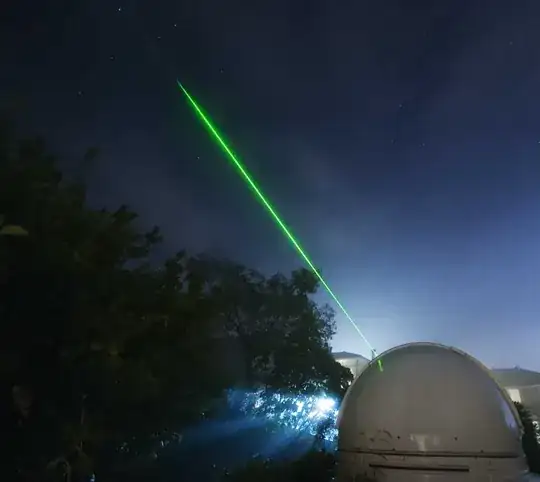At high enough energies to be "interesting" (i.e. a lethal weapon) the energy of the laser beam will be absorbed by the molecules of gasses that make up the atmosphere.
The initial effect is simply to recreate a lightning bolt effect (the air rapidly expands, then rushes back into the low pressure pocket where the beam passed, creating a thunderclap).
As the amount of energy in the beam increases, the air molecules themselves will become affected by the beam, ionizing and creating a plasma. Sadly for you, the plasma has the effect of absorbing the laser energy in a positive feedback effect, until the beam energy is blocked and no more energy hit the target. The plasma will actually flow up the channel towards the beam emitter, which would be disastrous in a mount inside the atmosphere, but we can safely assume the plasma bolt will dissipate somewhere in the high upper atmosphere.
As an aside, Leik Myrabo spent many years experimenting with the use of lasers to power spacecraft and aerospace vehicles, and used this effect to his benefit. Some of his designs used pulsed lasers shining into parabolic mirrors, which focused the laser energy to the point that the air underneath the vehicle "exploded" and provided the pulse of energy needed to lift the craft. Doing this multiple times a second provided the energy to lift these small craft.
https://www.youtube.com/watch?v=LAdj6vpYppA
https://www.youtube.com/watch?v=5_9ac-w4DW8
The effect of air absorbing the laser's energy limits the use of laser weapons to rapid pulses, and designers will need to "tune" the frequencies of the laser to avoid the energies that will preferentially interact with common atmospheric gasses like nitrogen. This may limit the use of lasers in the atmosphere to relatively unprotected targets; you won't be able to deposit enough energy on a tank in a short enough time frame, but you can shoot down missiles, artillery shells and even the helicopter or UAV firing the missiles or spotting for the gunners. Ships at sea can also be protected by a "no go" zone which enemy incoming munitions would have to pass, thinning out all but the densest swarm attacks and giving point defences a much better chance to protect the ship.
